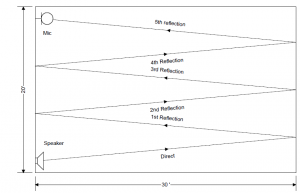Home > BLOG CENTER > The tail length of an conference system AEC
Home > BLOG CENTER > The tail length of an conference system AEC
The tail length of an AEC is the length of time over which it can cancel echoes. The tail length of the echo canceller should meet the requirements of the room it is to be operated in. This is directly related to the reverberation time of the room. As the room reverberation time increases, a longer tail length will be needed in that room. If the reverberation time is much longer than the tail length, a significant amount of the echo will remain audible. However, excess tail length will not improve or degrade the performance of the canceller. Determine the minimum tail length requirements for an application based on the typical acoustics of rooms the product will be used in. Any products that do not meet or exceed that tail length should not be used in that application.
There are two main factors that affect the reverberation time of a room. They are room size, and the materials used to construct the walls and objects in the room. Most sound is absorbed when it strikes walls or other surfaces. If materials are used that absorb sound well (such as carpet, curtains, or acoustic tile), the reverberation will die out more quickly than if the room contains mostly reflective materials (hard wood, glass, or plaster). If a room is small, the sound waves will bounce off the walls more frequently, and will be absorbed more quickly.
The following formula is useful in determining the necessary tail length for an environment. It relates the tail length to the room size and the number of cancelled reflections.
T = (N + 1) * d / c
The equation assumes that both the microphone and the speaker are mounted on the same wall (which is the worst case in terms of the number of reflections that will be cancelled). In that case, N must be an odd integer because the even reflections travel away from the microphone.
For example, consider a 10x20x30 foot conference room with very reflective surfaces that requires 5 echoes to be cancelled. In such a room, a tail length of 6 * 30 / 1125 = 160 ms would be needed. Figure 2 shows how these reflections would travel back and forth across the room.

40088 41166info@meeteasy.com.hk
3/F,Building#10, Jiu Xiang Ling Industrial Zone,Xili
Nanshan District, Shenzhen, 518055, China